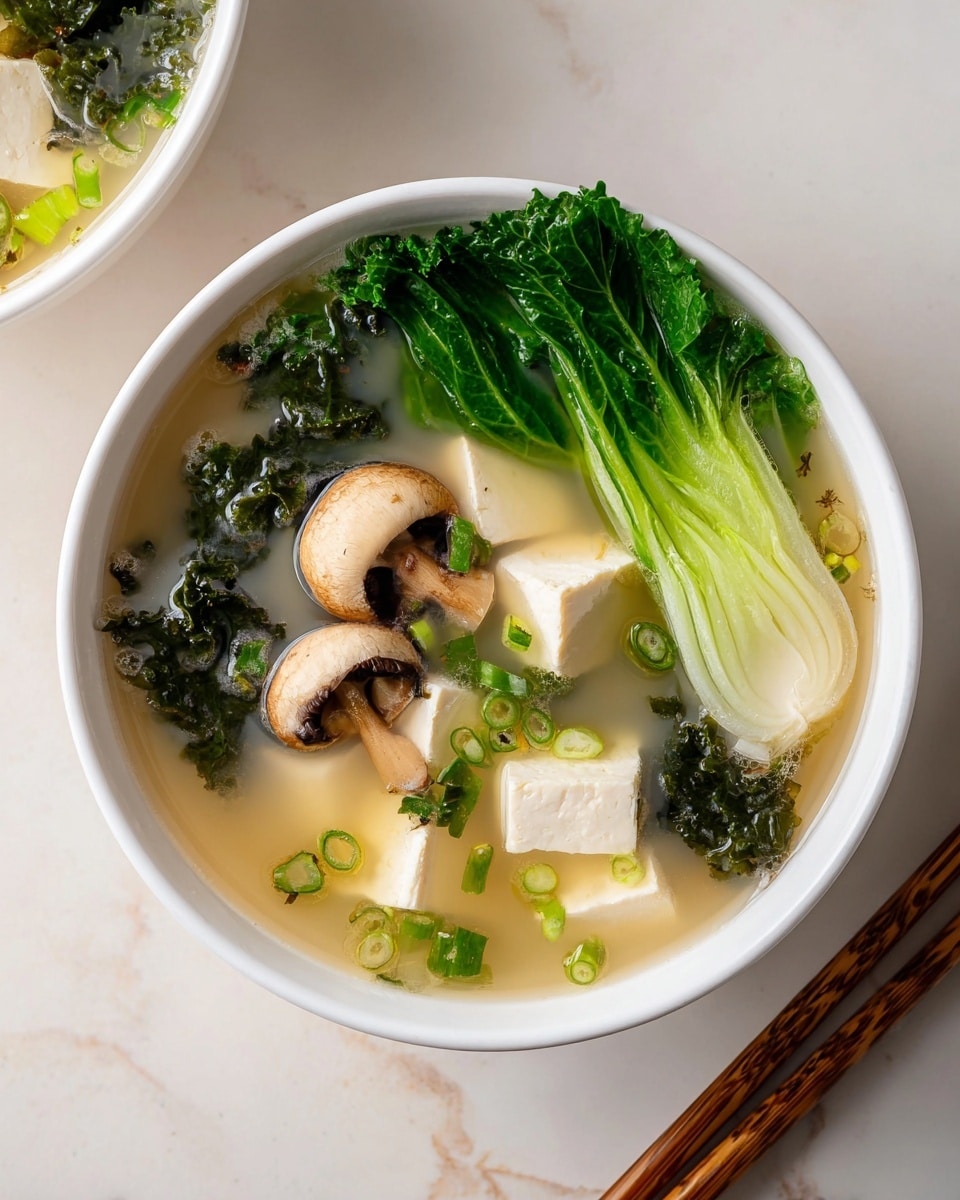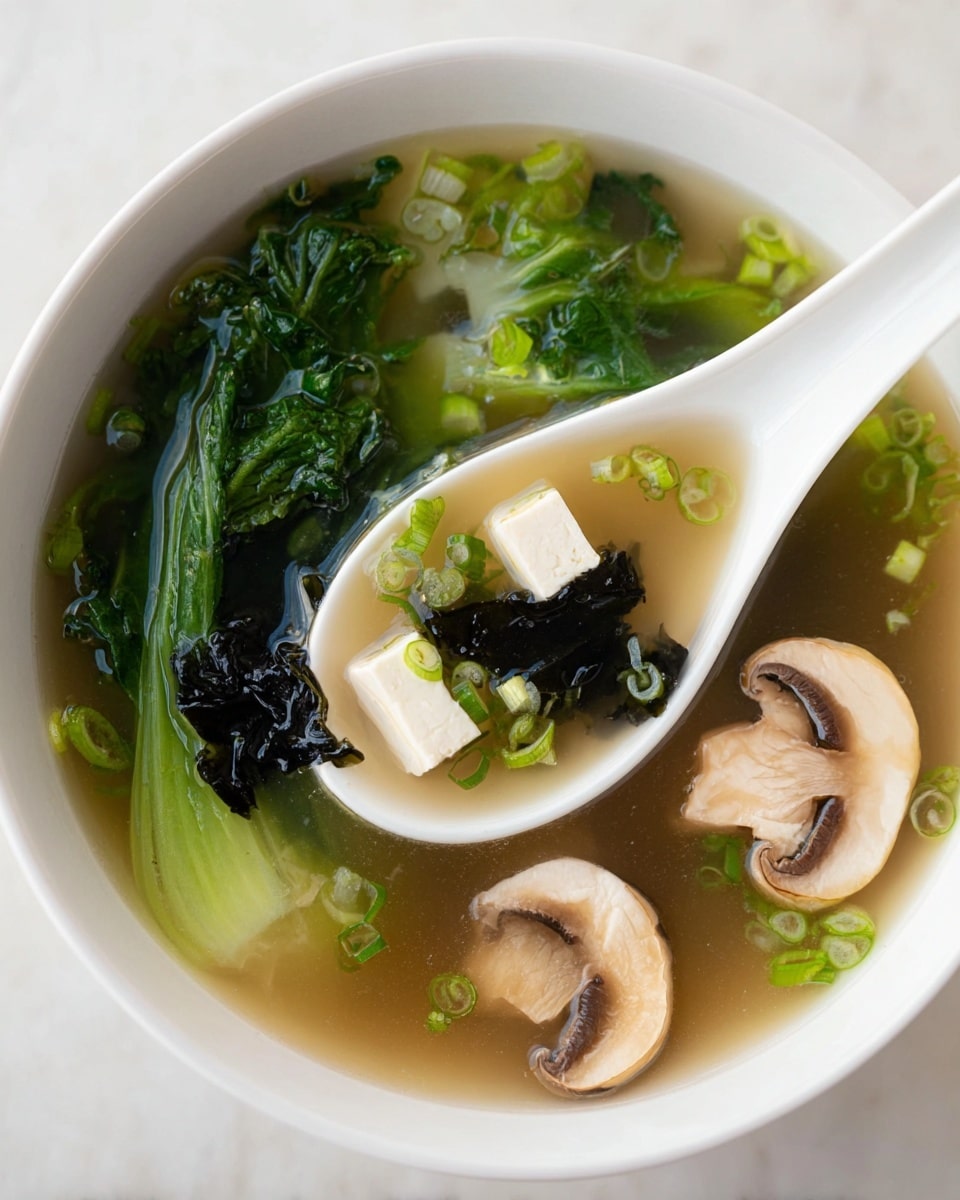Gluten-Free Miso Soup Recipe
I can’t tell you how many times a good bowl of miso soup has made a chilly evening feel instantly cozy. This Gluten-Free Miso Soup Recipe is a go-to in my kitchen when I want something nourishing, simple, and totally comforting. What makes it special? It’s packed with umami from the mushrooms and seaweed, plus that velvety tofu which adds a lovely texture – and best of all, it’s completely gluten-free without sacrificing an ounce of flavor.
Whether you’re new to miso soup or a longtime fan, you’re going to appreciate how easy this recipe is to whip up on a weeknight or whenever you need a warm hug in a bowl. I’ve played around with this recipe a bit to keep it both authentic and friendly for anyone avoiding gluten, and I’m excited to share everything I’ve learned with you!
Ingredients You’ll Need
The beauty of this Gluten-Free Miso Soup Recipe is in the simplicity of the ingredients, which all come together for a deeply satisfying result. When shopping, keep an eye out for high-quality gluten-free dashi powder and white miso paste – these are your flavor game-changers!
- Water: The base of your soup; tap water works fine but filtered water can enhance flavor.
- Gluten-free Dashi powder: Dashi is essential for that tasty broth with umami richness; make sure it’s labeled gluten-free.
- Mushrooms (Oyster, Enoki, or Shitake): Adds earthiness and texture; I love mixing varieties for extra depth.
- White miso paste: The star ingredient! Choose white miso since it’s milder and less salty, balancing the broth perfectly.
- Firm silken tofu: Cut into 1” squares; it provides silky texture and protein without overwhelming flavors.
- Wakame seaweed (or Nori): Gives a subtle briny note and lots of nutrients; rehydrate briefly before adding.
- Baby bok choy: Adds freshness and gentle crunch to the soup; slice it thin for the best bite.
- Sesame oil: Just a drizzle at the end to bring everything together with a toasty finish.
Variations
I love how adaptable this Gluten-Free Miso Soup Recipe is. Over time, I’ve put my own spin on it depending on what’s in season or what I’m craving, so don’t hesitate to personalize your bowl!
- Extra veggies: I sometimes toss in shredded carrots or thinly sliced daikon for a bit of crunch and color; it brightens up the soup wonderfully.
- Different proteins: If you miss a meatier bite, adding cooked shrimp or shredded chicken works well and keeps it gluten-free.
- Spice it up: A tiny splash of gluten-free chili oil or a sprinkle of togarashi adds exciting heat if you like things spicy.
- Herb twists: Fresh scallions or cilantro on top freshen the flavors and add a beautiful contrast.
How to Make Gluten-Free Miso Soup Recipe
Step 1: Create Your Umami Broth
Start by heating 6 cups of water in a pot and whisking in 1 tablespoon of gluten-free dashi powder until dissolved. This base is where the magic begins, so use good-quality dashi for the richest flavor. Bring it to a gentle simmer but avoid boiling vigorously — you want to coax the flavors out without losing subtlety.
Step 2: Add Mushrooms and Seaweed
Once your broth is simmering, add 6 ounces of your chosen mushrooms (I like oyster for their mild taste or shiitake for deeper flavor) and 2 tablespoons of rehydrated wakame seaweed. Let them soften gently, about 5-7 minutes. This step infuses the broth with earthy, ocean-inspired notes that are signature in miso soup.
Step 3: Incorporate Tofu and Bok Choy
Now toss in 1 cup of firm silken tofu cut into 1-inch cubes, along with a bunch of sliced baby bok choy. Cook just a couple of minutes more until the bok choy wilt slightly but still has a fresh bite. Overcooking here can make it mushy, so it’s best to keep an eye on the texture.
Step 4: Stir in Miso Paste Off Heat
This is a crucial step: remove the pot from direct heat before whisking in 3-4 tablespoons of white miso paste. Adding miso to boiling water can kill the beneficial probiotics and damage the delicate flavor. Dissolve it thoroughly so the soup becomes silky, then return to low heat just to warm through—no boiling!
How to Serve Gluten-Free Miso Soup Recipe

Garnishes
I’m a big fan of simple garnishes that add texture and sparkle. I usually drizzle a bit of toasted sesame oil on top for that irresistible nutty aroma. Sometimes I sprinkle finely chopped scallions or a few sesame seeds. These little touches make the soup feel special without much extra effort.
Side Dishes
This soup pairs beautifully with steamed rice or a light cucumber salad for a refreshing contrast. On days when I’m feeling fancy, I’ll serve it alongside gluten-free sushi rolls or a simple grilled fish. The balance of flavors is fantastic and makes for a well-rounded meal.
Creative Ways to Present
For special occasions, I like to serve this Gluten-Free Miso Soup Recipe in little ceramic bowls with a tiny side dish of pickled ginger or radishes. Adding edible flowers or microgreens on top can also elevate the presentation and wow guests while keeping everything gluten-free and vibrant.
Make Ahead and Storage
Storing Leftovers
I usually store leftover miso soup in an airtight container in the fridge for up to 2 days. Because miso is delicate, the soup tastes best when fresh, but leftovers still hold up well if reheated gently. I find the tofu stays nicely firm and the flavors meld even more after resting.
Freezing
Freezing this soup is possible but not ideal, mainly because the texture of the tofu and bok choy can get a bit watery or mushy after thawing. If you want to freeze it, I recommend removing the tofu and veggies first and freezing the broth separately. Recombine after thawing for best results.
Reheating
When reheating your Gluten-Free Miso Soup Recipe, do it gently over low heat, making sure not to boil it. I usually add an extra splash of water or dashi as it warms up to refresh the flavors and keep the broth silky. Stir frequently and stop heating as soon as it’s hot enough to enjoy.
FAQs
-
Is miso paste gluten-free?
Many white miso pastes are naturally gluten-free, especially those made from rice or soy, but some brands use barley or wheat. It’s important to check the label for gluten-free certification to ensure safety, particularly if you have celiac disease or gluten sensitivity.
-
Can I use regular dashi powder instead of gluten-free?
Regular dashi powder often contains wheat-based ingredients, so it’s best to stick to gluten-free dashi powder to keep this recipe safe. Look for dashi powders specifically marked gluten-free in specialty or online stores.
-
What can I substitute for wakame seaweed?
You can use nori sheets as an alternative by cutting them into thin strips or crumbling them into the soup. They won’t have the exact texture of wakame but will provide a delicious seaweed flavor that complements the broth.
-
How much miso paste should I use for this recipe?
For this Gluten-Free Miso Soup Recipe, 3 to 4 tablespoons of white miso paste gives just the right balance of flavor—rich enough without overpowering the other ingredients. Adjust to taste, but remember to stir it in off the heat to preserve its delicate qualities.
-
Can I add other vegetables to the miso soup?
Absolutely! Vegetables like carrots, daikon radish, or spinach work beautifully. Just add them early enough during cooking so they soften but don’t become mushy. Feel free to experiment and find your favorite combo.
Final Thoughts
This Gluten-Free Miso Soup Recipe is one of those comforting dishes that feels like a warm hug after a long day. I love how it’s quick, nourishing, and completely adaptable to what you have on hand. Once you make it your own, I promise you’ll reach for it again and again—whether it’s a cozy solo night or served up for friends. Give it a try, and I’m sure it’ll become a staple in your gluten-free cooking arsenal too!
Print
Gluten-Free Miso Soup Recipe
- Prep Time: 10 minutes
- Cook Time: 15 minutes
- Total Time: 25 minutes
- Yield: 4 servings 1x
- Category: Soup
- Method: Stovetop
- Cuisine: Japanese
- Diet: Gluten Free
Description
This comforting Gluten-Free Miso Soup features a flavorful broth made with gluten-free dashi powder and white miso paste, complemented by a medley of mushrooms, silken tofu, wakame seaweed, and tender baby bok choy. It’s a nourishing, savory soup perfect for a light meal or starter, offering rich umami flavors while being suitable for gluten-intolerant diets.
Ingredients
Broth
- 6 cups water
- 1 tbsp gluten-free dashi powder
- 3–4 tbsp white miso paste
Main Ingredients
- 6 oz mushrooms (Oyster, Enoki, or Shiitake)
- 1 cup firm silken tofu, cut into 1-inch squares
- 2 tbsp wakame seaweed (Nori can be substituted)
- 1 bunch baby bok choy
Finishing
- Sesame oil, for drizzling
Instructions
- Prepare the broth: In a large pot, bring 6 cups of water to a simmer. Stir in 1 tablespoon of gluten-free dashi powder until fully dissolved to create a savory base.
- Add mushrooms and seaweed: Add 6 ounces of your choice of mushrooms (Oyster, Enoki, or Shiitake) and 2 tablespoons of wakame seaweed to the broth. Simmer gently for about 5 minutes, allowing the flavors to infuse and mushrooms to soften.
- Incorporate miso paste: Reduce the heat so the broth is no longer boiling to preserve the probiotics in the miso. In a small bowl, ladle some of the hot broth and whisk in 3 to 4 tablespoons of white miso paste until smooth. Then gradually stir this mixture back into the pot, ensuring it’s well combined without boiling the soup.
- Add tofu and bok choy: Gently stir in 1 cup of firm silken tofu cut into 1-inch squares and a bunch of baby bok choy. Simmer for another 2-3 minutes until the bok choy is just tender but still vibrant green.
- Final touch and serve: Remove the pot from heat and drizzle a small amount of sesame oil over the soup for a fragrant finish. Serve immediately while hot, enjoying the balanced umami and fresh greens.
Notes
- Ensure the dashi powder is certified gluten-free to keep the soup suitable for gluten-intolerant diets.
- Do not boil the soup after adding miso paste to preserve its delicate flavors and nutritional benefits.
- Miso paste quantity can be adjusted to taste; start with 3 tablespoons and increase if desired.
- Use fresh mushrooms and bok choy for the best texture and flavor profile.
- Sesame oil is optional but highly recommended for added aroma and depth.
Keywords: miso soup, gluten-free soup, Japanese soup, tofu soup, mushroom soup, healthy soup, wakame seaweed, baby bok choy







